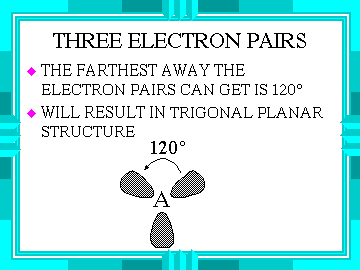
Figure 1. Example of a lecture slide.
Abstract
This paper presents my experience using different technologies in a freshman chemistry class, "General Chemistry 1035," at Virginia Tech, Spring 1996. I generated all lectures with computer presentation software, and presented them in class using computer projection equipment. I made available lecture notes, as well as problem sets, problem set solutions, exam solutions, and student scores, on a World Wide Web (WWW) site. The course also utilized e-mail, a class listserv list and a local newsgroup. I found all of these technologies, or just one or two of them, easy to fold into a traditional lecture course. The paper discusses some of the pluses and minuses of these technologies and also relates students' viewpoints based on a questionnaire.
In Spring 1996, I taught a section of our general chemistry course, "Chemistry 1035." This is the "trailer" section; most of the students had taken it at least once before and had either failed it or dropped it. Approximately 300 students of widely varying backgrounds from just about every possible major on campus met in a very large lecture hall that would more appropriately be called a theater. My task was to make the presentation material easily readable for those students in the back of the hall, at the same time interacting on a more than superficial level with that large number of students. I chose to follow the path of simple technology.
Information Technologies Used
Computer generated overheads.
There are no blackboards in McBryde 100 (the lecture hall for
this course) and it would be very difficult to see a blackboard
from the back of the hall. Usually the professor uses two overhead
projectors spaced to project side by side on a large screen on
the stage, and then writes on blank transparencies or uses pre-made
transparencies for the lecture. I was concerned about having consistently
readable text if I were to write on blank transparencies while
I was lecturing. I therefore made lecture overheads ahead of time
with large font sizes so that anyone could see them clearly from
the back of the room. My software choice at this point was Microsoft
PowerPoint 3.0, a choice influenced in no small part by that package's
ability to easily handle superscripts and subscripts, a must for
a chemical lecture.

Originally my intent was to make hard-copy
overhead transparencies from this program and then show them using
the overhead projectors in the lecture hall. However, when I discovered
computers and computer projection equipment in McBryde Hall, instead
of making hard copies, I decided to use the projection equipment.
Help sessions.
In order to ensure that my students were capable of taking advantage
of the technologies, I publicized the schedule of help sessions
available from the University to give new students information
about how to use e-mail and such. Also, in the second week of
class, I devoted an entire lecture to a step-by-step demonstration
of e-mail, accessing World Wide Web pages, accessing the newsgroup,
etc.
I must also point out that all of the above
were in addition to the traditional sorts of activities that I
try in order to help my students. While I used the computer system
to show some movie clips, I did numerous in-class live demonstrations
of chemical concepts. I schedule quite a number of help sessions
each week where the students could come and ask me to work out
some problems in detail. These were relatively well attended,
but there were generally no more than 30-50 of the 300 students
at any help session. I also had a very liberal office hour policy.
Computer projection.
One advantage of using computer projection is that the full color
of the original slides comes through and so you can use color
to highlight important points. In addition, the presentation software
allows one to click through the lecture as a slide presentation.
Each point on a slide can be built one at a time. With the addition
of an infrared sensor to the computer, the slide advance can be
controlled from anywhere on the stage and the lecturer is not
restricted to staying at the computer. The use of the computer
allows movies and sounds to be built right into the presentation.
With the particular setup in this lecture hall, the projector
was bright so the hall lights did not have to be dimmed.
The WWW site.
Once the lecture notes were in a computer format, it was an easy
extension to make the class notes available to the students on
a WWW site. I made the notes available a day or two before lecture
so the students could print them out and use them as templates
for their in-class note taking. I prepared these lecture notes
using PowerPoint and made them available on the website in Adobe
Acrobat (pdf) format. I used two different forms, both easily
accessible from the print command of PowerPoint. The first form
had one lecture slide per page for those students who wanted a
lot of extra room to write on the sheets. The second form had
six slides printed on each 8.5 x 11" sheet of paper for those
students who didn't want to print out a lot of pages.
See a sample of the normal format for lecture notes: Normal Notes See a sample of the compressed format for lecture notes: Compressed Notes |
Once the WWW site was up and running, I could place other material on the site for the students' use. Information on the site included the course syllabus, information about the course newsgroup, problem set worked solutions, exam worked solutions and a link to the students' grades.
Class listserv. Virginia Tech has made it very easy to set up a class listserv list based on the class roster. All Virginia Tech students receive e-mail ids when they enroll; thus all students have the potential to access e-mail. A simple request to the listserv coordinator on campus sets up the list for the class for the semester. A message sent to the list is transmitted to all students. For a small class this may not be so important, but for a large class of 300, this was essential.
Class newsgroup. The news coordinator for the campus has made it very easy to set up a local vt.class.* newsgroup for use by the class during the semester. A simple e-mail request has the class established a day or two later. Students can then post questions to the group and I encouraged other students to try to answer these.
Personal Perceptions: The Pluses and Minuses
Computer generation of overheads. Because I am very comfortable with a computer, I type and manipulate computer images with ease, so it was quite natural and easy for me to put together lectures using the computer. Putting together an outline for each lecture and then fleshing out the slides kept the lectures organized and to the point. One big plus that I see for the future is that it will be extremely easy to revise this course and keep it fresh. One drawback is that I was tied to the computer for preparing my lectures. This necessitated having a computer at home as well as in my office. (A laptop computer might be a good purchase.) Add to this the need for a scanner, and equipment costs can be quite high for a given individual.
Computer projection of lectures. Although computer projection of lecture material fit very well with my lecture style, I did not completely abandon the old ways. Right next to the computer projection on the screen I had a traditional old overhead projector so that I could embellish points by hand. There are several potential pitfalls in the use of computer projection. First, you have to resist the tendency to zip through the material faster than the students can absorb it (this is not unique to computer projection but is a danger for any pre-prepared slides.) Second, if you are counting on using a computer and projector, they had better work. At Virginia Tech, we have an audio-visual support person assigned to set up the computer and the projector; for smaller institutions, this might not be possible. Also, it is very important that the projection be bright and readable without dimming or turning off the classroom lights. (First generation LCD panels for overhead projection now seem totally inadequate.) Darkening the room means losing a number of students. Again, this translates into large costs, both for projection equipment and for support for that equipment.
WWW site. Our Chemistry Department has its own Web server, and mine was already set up. Professors in smaller departments on campus can get space on the library Web server for courses, so there is no problem in finding places to put the material. I view the Web page as the cyberspace analog of the bulletin board outside my office. Instead of tacking problem solutions to the bulletin board, I place them on the website. I don't see very many disadvantages to this. Some colleagues have told me that they want to force their students to come by their office to see things and then maybe they will stop in and ask questions. My experience in teaching this same course previously without Web pages is that this just doesn't happen. So, anything I can do to encourage the students to take advantage of this added information is a plus. I can also compare the Web page material to hard-copy material I have placed on reserve at the library. Prior to spring 1994, I placed much of the same information on hardcopy and put it on reserve in the library reserve desk. The sign-out sheets we required students to use and that indicate the number of hits this material is getting showed me that the hardcopy reserve material usually had only a dozen or so students viewing it. On the other hand, the Web page for my course had in the range of 500-1000 hits per week.
Class listserv. This was a big plus, with only a couple of minor reservations. It was easy to established a list Virginia Tech, but there were still a number of students who weren't taking advantage of their e-mail IDs. I had to remind students at just about every class to read their e-mail. The other reservation is that, for a class as large as this one, I had to be the moderator for the list and not let students just send to the list directly. An unfortunate situation rose early where one student wrote that she thought I was going a bit too fast in lecture. A number of others immediately wrote and criticized the first student for saying that and it went downhill from there. A moderated list worked out much better.
Class newsgroup. The concept was a good one, but there were a couple of issues that kept this from being as useful as it might have been. First, the inability to post chemical equations (using superscripts and subscripts) was something of a drawback. The more important drawback, though, was the students' lack of familiarity with the concept. While it was relatively easy to show students how to use a Web browser and how to get to a particular Web address, subscribing to a newsgroup and taking advantage of it posed a slightly higher level of difficulty that limited its usefulness. With the advent of Web page based chat-forums, this might be more useful in the future.
Student Perceptions
At around mid-term and at the end of the term,
I asked students to answer a questionnaire concerning the course
and about the technologies that we used in the course. The total
number of respondents for the questionnaire was 254 out of the
300 enrolled, so the responses represent the bulk of the students
in the class. The following presents the wording of the survey,
some graphic presentations of the results, and a few personal
comments.
For the following questions, tell me about
the usefulness of some of the procedures followed in this class
on a scale of 1-10 with 1 meaning not useful at all, and 10 meaning
very useful and numbers in between meaning different degrees of
usefulness.
1. How useful do you find e-mail for asking
the instructor questions?
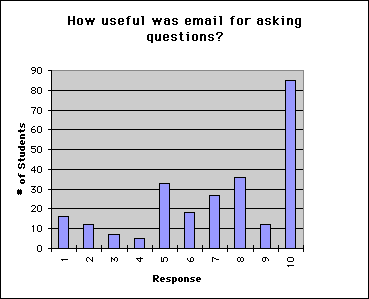
The mean response for this question was 7.1,
and the chart shows that, although a large number found it very
useful ( 85 "10" responses), a large fraction were neutral
or didn't find it useful at all. (73 responses of 1-5).
2. How useful do you find e-mail for getting
news and information from the instructor?
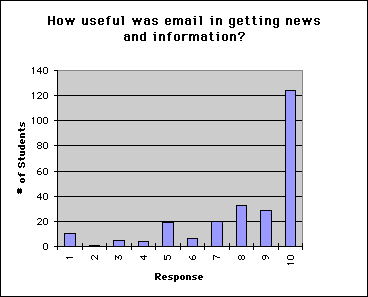
Here, the response was much more positive.
The mean response was 8.3 and the number of "10" responses
was 124. Overall, students liked e-mail more for finding out information
from me.
3. How useful do you find the newsgroup for
asking questions about course material?

The mean response here was only 5.7. I think
this reflects my beliefs that the students found it difficult
to use the newsgroup and just weren't familiar enough with the
concept of newsgroups to take advantage of it.
4. How useful do you find the newsgroup for
getting news and information from the instructor?

The mean response to this question was 6.3.
The distribution above shows that most really didn't find the
newsgroup very useful.
5. How useful do you find the Web page overall?
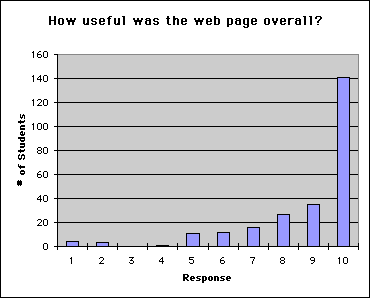
There was an overwhelming positive response
to the use of the Web material overall. The mean response was
an 8.8 and the distribution above clearly shows most of the students
found the Web page very useful.
6. How useful do you find the class notes
which are available on the Web page?
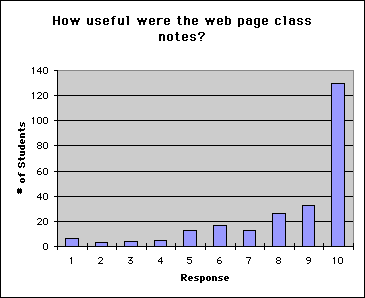
The mean response to this question was 8.4.
7. How useful do you find the problem sets
and solutions on the Web page?

The mean response here was 8.7.
8. How useful do you find the exam solutions
on the Web page?
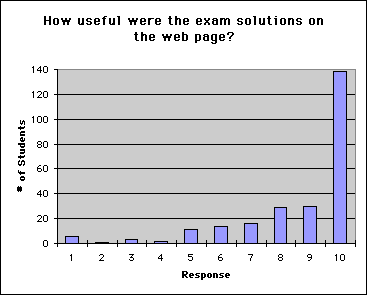
The mean response was 8.6.
9. How useful do you find the score postings
on the Web page?
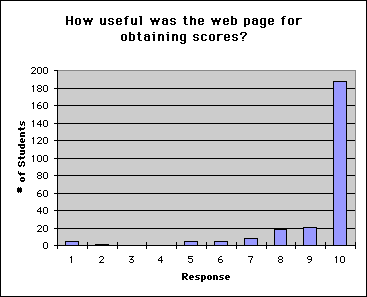
I guess I shouldn't be too surprised that
the biggest positive response from the students dealt with finding
their grades on the Web pages. This had a mean response of 8.3;
187 of the 254 responders rated this feature a 10.
10. How useful do you find the problem sessions?
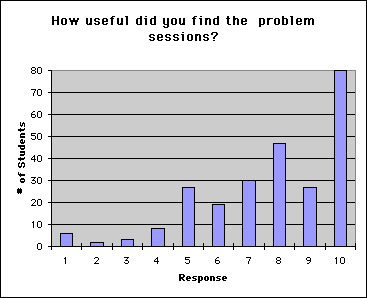
Mean response was 7.7.
11. How useful do you find the instructor's
office hours?

Mean response was 6.6.
The last two questions were not on the technology,
but on the more traditional ways by which we can enrich the students'
class experience. The contrast in response for questions 10 and
11 with many of the other questions lies at the heart of what
we are calling asynchronous learning. My schedule for hours and
problem sessions may not nicely dovetail with my students' schedules.
Due to class schedules, work schedules, sports schedules, etc.,
many students just couldn't take advantage of some of the more
personal offerings that I made. However, at 3:00 am, they could
take advantage of the Web page and did.
Conclusions
The experience described above really applies
to one professor and one course. In several different ways, computer
technology and cyberspace allowed me to try to meet the needs
of my particular students. Nevertheless, there are some general
lessons that all can learn from this. One is that various computer
technologies can be a very rewarding and enriching supplement
to many of the traditional approaches to teaching large lecture
classes. Use of the computer didn't save me any time, but it did
enable me to reach more of my students than I could have done
using more traditional means. I firmly believe that it has made
my class better, and the student responses clearly support that
view.
What about the part of my title that says:
You can walk before you run? For some of my colleagues, talking
about (and running with) technology, asynchronous learning, Web-based
courses, etc., is all the rage today. Even some who have not yet
taken the plunge see technology as a world of glitz and sparkle
with multimedia Web pages. But many others are intimidated and
question their ability to learn that technology stuff. The important
thing is that you don't have to begin with all that stuff. You
can walk in to computer technology, gradually including it in
your classrooms, at a minimal level. As instructors, you can begin
with just an expanded use of e-mail. Then, as you get more comfortable,
you can add a website with some introductory information. And
so on. These are all great tools for reaching our students and
fear of running with the whole package shouldn't be reason for
avoiding technology; just try walking before running.
